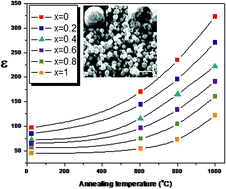Annealing effects on the crystallite size and dielectric properties of ultrafine Ba1−xSrxTiO3 (0 < x < 1) powders synthesized through an oxalate-complex precursor
Abstract
Nanocrystalline Ba1−xSrxTiO3 (0 < x < 1) nanopowders were prepared through the oxalate route and the influence of the thermal history on their dielectric properties was investigated. For pelletized samples obtained by decomposing the corresponding oxalate intermediates at 600 °C and then annealed at different temperatures ranging from 600 to 1000 °C the dielectric constant decreases upon increasing the strontium content of the samples. Similar behavior was observed with decreasing the temperature of the thermal treatment of the pellets, a trend which is presumably ascribed to a synergic effect of decreasing the porosity of the samples, the increase of the crystallite size as well as the growth of nanograins. Additionally, a two-fold increase of the dielectric constant is also achievable by using a different annealing strategy, which consists of the direct heat treatment of the intermediates at different temperatures ranging between 600 and 1000 °C. In this latter case, the experimental data unambiguously show a direct correlation between the variation of the dielectric constant and that of the crystallite size/microstrain of the BSTO nanopowders.


 Please wait while we load your content...
Please wait while we load your content...